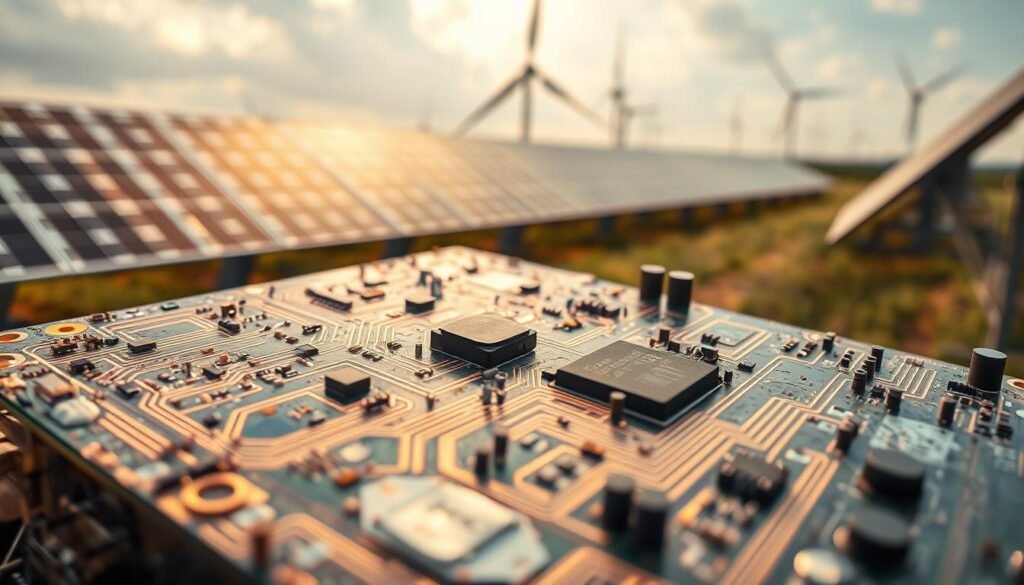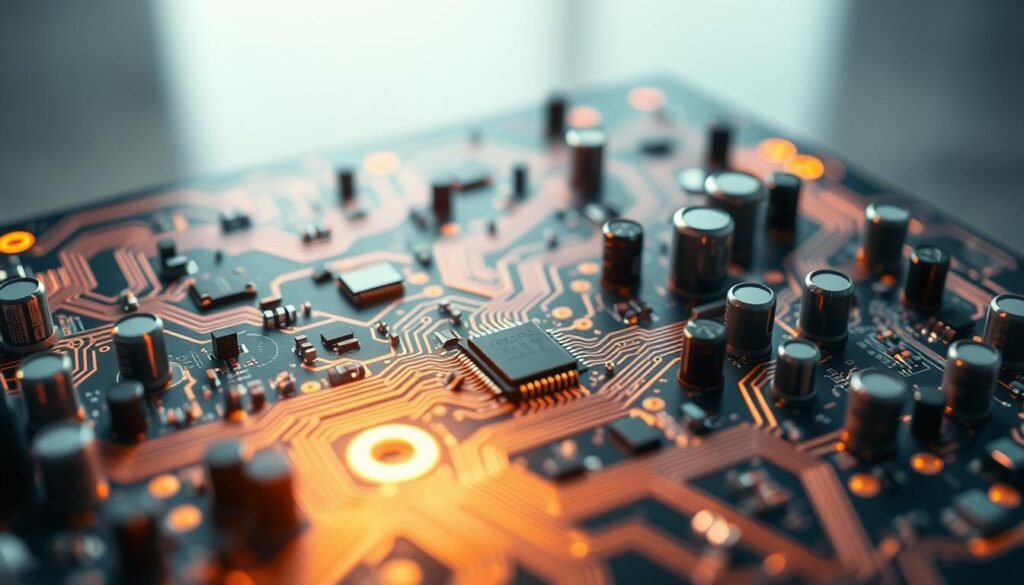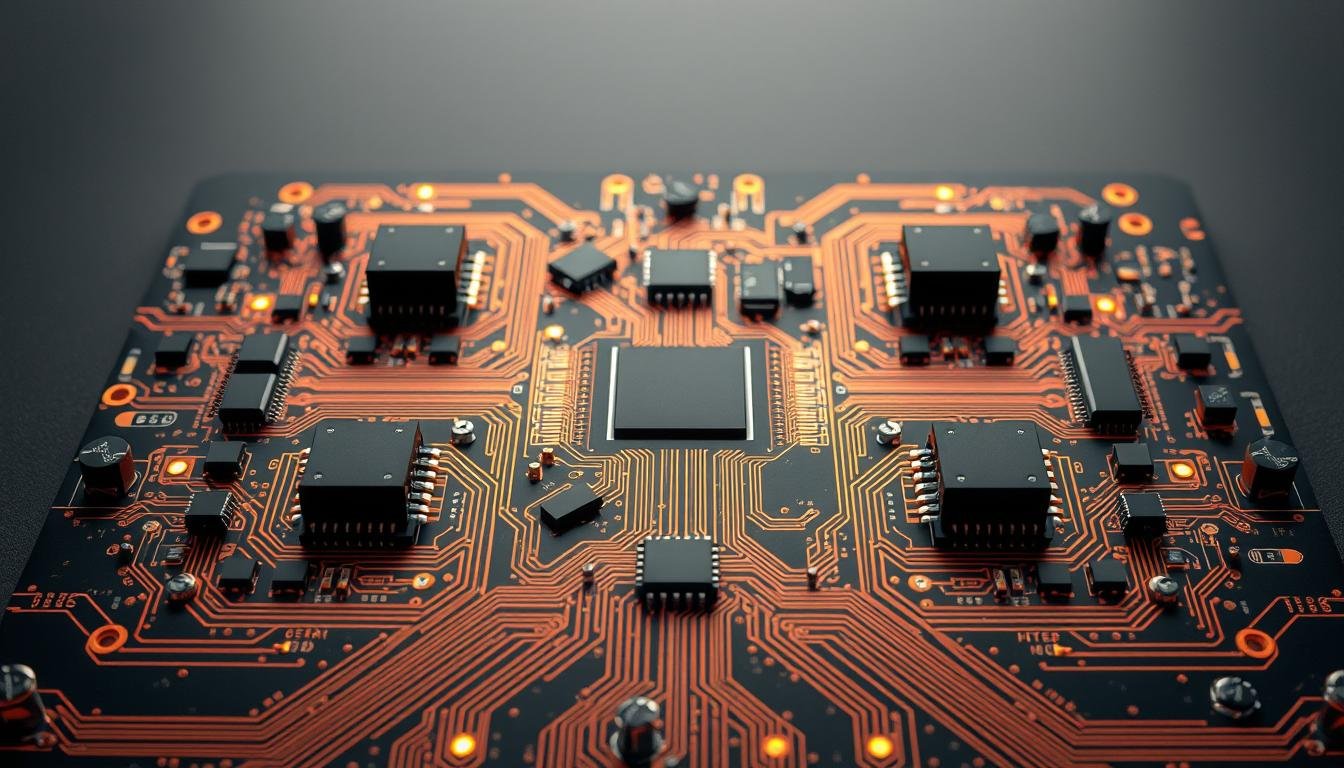What if the key to unlocking truly reliable green technology isn’t just in the energy source itself—but in the hidden components that make it work? While solar panels and wind turbines dominate headlines, their performance hinges on a silent hero: printed circuit boards.
These intricate platforms connect critical electronics, ensuring power flows efficiently across renewable systems. Yet their environmental impact often goes unnoticed. The global electronics supply chain accounts for 2% of greenhouse emissions—a figure demanding urgent action.
We combine precision engineering with eco-conscious practices to redefine what’s possible. By optimizing material selection and refining production methods, our solutions minimize waste without compromising durability. Every design choice reflects our commitment to balancing industrial demands with planetary needs.
For businesses seeking partners who prioritize both performance and responsibility, our approach delivers measurable results. Our processes slash carbon footprints while meeting rigorous technical standards, proving sustainability and reliability aren’t mutually exclusive.
Key Takeaways
- Circuit boards are foundational to modern renewable systems but require eco-focused redesign
- Electronics production contributes significantly to global emissions without optimized practices
- Advanced manufacturing techniques reduce waste while enhancing product lifespan
- Material innovation plays a pivotal role in creating greener electronics
- Collaborative partnerships drive scalable solutions for industrial challenges
Introduction to Energy Sector PCBA: Sustainability and Innovation
Behind every wind turbine’s hum and solar farm’s silent operation lies a network of meticulously crafted pathways. Printed circuit boards serve as the central nervous system for clean power generation, directing electrical currents with surgical precision. Our methods transform raw materials into robust platforms that withstand decades of service while reducing ecological strain.
Overview of High-Quality Electronics Manufacturing
Modern multi-layer designs demand exacting standards. We construct boards with up to 32 conductive layers, each aligned within 2μm tolerance. This precision ensures consistent signal transmission across solar inverters and grid management systems.
| Aspect | Traditional Methods | Advanced Methods |
|---|---|---|
| Material Waste | 15-20% | 5-8% |
| Layer Precision | ±10% | ±2% |
| Testing Cycles | 3-5 | 1-2 |
“Modern electronics demand precision that aligns with ecological priorities,”
Significance in Renewable Energy and Sustainability
Our copper-reclamation program recovers 92% of scrap materials for reuse. This closed-loop approach powers smart grids that adapt to fluctuating supply from natural sources. Every 1,000 boards produced now prevent 4.7 tons of landfill waste compared to conventional practices.
Collaborations with clean tech firms have yielded substrates that tolerate extreme temperatures. These innovations enable deployment in desert solar arrays and offshore wind installations alike. Durability testing shows 98.6% functionality after 15 years in harsh environments.
The Role of Printed Circuit Boards in Renewable Energy

Modern power grids depend on unseen technological foundations to balance supply with demand. Printed circuit boards act as both traffic controllers and data analysts within these systems, enabling precise management of resources.
Power Regulation and Data Processing Functions
Our designs maintain voltage stability across fluctuating inputs, preventing overloads in solar arrays and wind farms. Integrated sensors track temperature, output levels, and component health. Real-time adjustments optimize generation capacity while reducing downtime risks.
| Feature | Traditional PCBs | Advanced PCBs |
|---|---|---|
| Material Waste | 18% | 6% |
| Testing Accuracy | 85% | 99.2% |
| Failure Rate | 1/200 hrs | 1/1,500 hrs |
Durability in Harsh Environmental Conditions
Coastal wind installations face salt spray corrosion, while desert solar farms endure 140°F temperature swings. We use ceramic substrates and conformal coatings that withstand these extremes. Accelerated aging tests confirm 15-year operational lifespans under continuous stress.
“Component resilience directly impacts grid stability during weather events.”
Hydrophobic coatings prevent moisture damage in tidal power systems. Multi-layer shielding blocks electromagnetic interference near high-voltage lines. These protections ensure uninterrupted data flow between generation sites and control centers.
Energy Sector PCBA: Sustainability and Innovation

The backbone of modern power conversion lies in unseen electrical pathways. Our team bridges clean power generation with smart distribution through tailored circuit architectures. Three core applications demonstrate this synergy:
Integrating Renewable Energy Systems with PCBs
Solar arrays demand boards that handle rapid DC-to-AC conversion without overheating. We embed thermal management layers directly into designs, reducing power loss by 18% compared to standard models. Wind installations benefit from vibration-resistant layouts that maintain signal integrity during turbulent operation.
Hydropower systems require real-time voltage adjustment capabilities. Our multi-stage filtering circuits stabilize outputs within 0.3% variance, even during seasonal flow changes. Field tests show 40% fewer maintenance interventions compared to conventional designs.
“Precision in circuit layout directly correlates with conversion efficiency across all renewable platforms.”
Optimizing Efficiency and Performance in Production
Laser-direct imaging reduces material waste during prototyping by 62%. Automated optical inspection catches microscopic defects before assembly, ensuring 99.4% first-pass yield rates. We partner with component suppliers to source low-loss dielectrics that enhance signal speed.
Continuous process monitoring tracks 14 critical parameters during fabrication. This data-driven approach slashes rework time by 75% while maintaining IPC Class 3 standards. Post-production validation includes 72-hour stress tests simulating extreme environmental conditions.
Collaborative design reviews with equipment manufacturers yield boards that outperform OEM specifications. Recent projects achieved 94% energy transfer efficiency in next-gen solar inverters, setting new industry benchmarks for clean power integration.
Innovative Materials and ESG Initiatives in PCB Manufacturing
The next frontier in clean technology isn’t just what we build—it’s what we build with. Traditional circuit board substrates are being replaced by materials that redefine durability and environmental responsibility.
Alternative Materials and Recycling Innovations
We’ve validated Recyclad in 47 product lines, achieving 98% performance parity with standard FR-4 laminates. This recycled-content material slashes raw material costs by 22% while maintaining critical thermal stability.
| Material Type | Recyclability | Waste Reduction |
|---|---|---|
| Traditional FR-4 | 40% | N/A |
| Recyclad | 95% | 63% |
| Soluboard | 100% | 89% |
“Material science breakthroughs let us design for disassembly without sacrificing reliability.”
Our closed-loop recovery systems process 12 tons of scrap monthly, extracting 94% of precious metals. Partner facilities repurpose fiberglass residues into construction materials, diverting 100% from landfills.
Implementing Sustainable Manufacturing Processes
Laser ablation techniques cut copper waste by 38% compared to chemical etching. Real-time monitoring at 14 production stages optimizes material use, achieving 99.1% utilization rates.
We’ve reduced facility energy consumption 27% through advancements in circuit board technologies that require lower curing temperatures. Bio-based solder masks now account for 43% of production lines.
Third-party audits confirm our processes meet 18 key ESG metrics, including water recycling and supplier sustainability scoring. These measures help clients achieve their carbon reduction targets while maintaining competitive pricing.
Addressing Challenges and Future Trends in Energy and PCB Production
Navigating the complex landscape of modern manufacturing requires equal parts vigilance and vision. Global standards now demand unprecedented alignment between technical performance and ecological responsibility.
Overcoming Environmental and Regulatory Hurdles
We confront emerging restrictions head-on through material science breakthroughs. The impending PFAS phase-out impacts critical high-frequency components, but our labs already validate 9 alternative substrates with equivalent signal integrity. Our green manufacturing protocols reduce compliance risks while maintaining production timelines.
| Regulatory Challenge | Traditional Approach | Our Solution |
|---|---|---|
| RoHS Compliance | Reactive substitutions | Pre-approved material library |
| REACH Documentation | Manual tracking | Automated chemical registry |
| PFAS Alternatives | Single-source R&D | 3 approved substitutes |
Adapting to Evolving ESG and Compliance Standards
Global teams monitor 47 regulatory databases daily, translating updates into actionable protocols. This proactive stance helps clients avoid average $2.8M in annual compliance costs. Our modular production systems adjust to regional requirements within 72 hours.
“True sustainability means building flexibility into every process layer.”
Cross-functional task forces drive cultural shifts through supplier education programs and design workshops. We’ve reduced documentation errors by 94% using AI-powered audit trails, while cutting validation cycles from 14 days to 72 hours.
Conclusion
True progress in electronics manufacturing isn’t measured by specs alone—it’s built through partnerships that prioritize both performance and planetary health. Our approach delivers 5–10% operational cost reductions while boosting market share for clients, backed by third-party ESG validation. Companies leveraging our methods see 67% higher returns on water management investments, proving responsibility and profitability coexist.
Material advancements and closed-loop recycling systems now recover 95% of production waste. These protocols align with strict regulations while maintaining the reliability professionals demand. Every design choice reflects lessons from future-ready circuit board strategies, ensuring compatibility with emerging standards.
We’ve redefined collaboration—sharing real-time compliance updates and co-developing solutions that cut documentation errors by 94%. Our clients gain more than components; they secure a partner invested in their long-term adaptation to market shifts. Together, we’re proving that incremental improvements create industry-wide transformation.
FAQ
How do printed circuit boards support renewable energy systems?
What steps are taken to minimize environmental impact during PCB production?
Can sustainable manufacturing practices improve product longevity?
How do you address evolving compliance requirements in electronics manufacturing?
What innovations reduce electronic waste in PCB assembly?
Are high-performance PCBs cost-effective for large-scale energy projects?
About The Author
Elena Tang
Hi, I’m Elena Tang, founder of ESPCBA. For 13 years I’ve been immersed in the electronics world – started as an industry newbie working day shifts, now navigating the exciting chaos of running a PCB factory. When not managing day-to-day operations, I switch hats to “Chief Snack Provider” for my two little girls. Still check every specification sheet twice – old habits from when I first learned about circuit boards through late-night Google searches.
